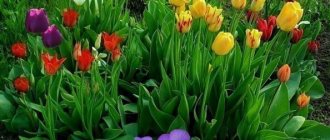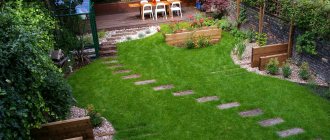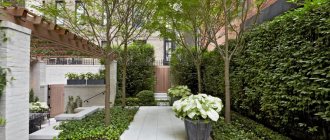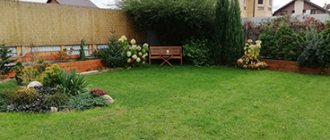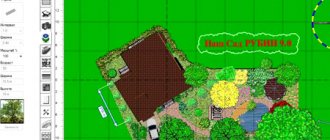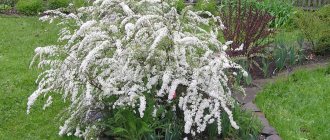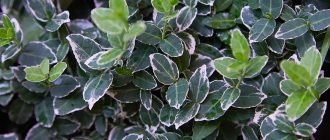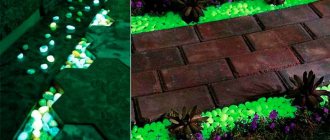History of the rock garden
Its ancestors can be called ancient rock gardens from Japanese culture. But real mountain flower beds first appeared in 16th century England. At that time, court researchers actively imported and grew alpine plants. In order for the seedlings to take root well in local gardens, mountainous areas with stones and sand were erected for them, very similar to modern alpine flower beds.
Large rock garden in the city park
During the Golden Age of Botany (1700-1800s), rock gardens experienced a peak in popularity throughout Europe. They first appeared in Russia in the mid-18th century. Interest in them did not subside until the beginning of the Second World War. Today, the rock garden is again one of the most popular elements of landscape design: spectacular, easy to care for and durable.
Choosing plants for rock gardens
Despite the fact that in rock gardens the emphasis is on stones, the choice of plants also needs to be approached thoroughly. Otherwise, you can visually spoil the idea.
Plants must comply with the following rules:
- Low growth rate. It is unacceptable for plants to quickly cover the surface.
- The requirements for growing conditions are the same for everyone.
- Heat resistance - in rock gardens, stones heat up quickly; not every plant can withstand the heat.
- Association with rocky terrain. There should be a feeling that the plant grew here on its own, and not with the help of a person.
- Moderate variegation - visually the plant should not dominate the rest of the composition.
You should not choose too many plants. For a rock garden, area. For 10 sq.m, it is enough to select 10–12 types of plants. In addition to the herbs and flowers listed above, you can sow decorative onions, cinquefoil, and sedum. Coniferous trees include thuja, juniper, dwarf pines and spruces.
Succulents look appropriate in Japanese-type rockeries.
Varieties of “rock gardens”
Alpine slide
The traditional and most common version of a rock garden. The main feature is the imitation of a natural mountain landscape with its flora. The hill is crowned by one or several large boulders. Around them are smaller stones, gravel and sand paths, diluted with ground cover plants and mini-shrubs.
It is better to place the alpine slide in the center of the site
Rockery
Or "rocky garden". Its differences from a traditional alpine flower bed:
- Smooth surface,
- accents on tall plants and decorative stones,
- possibility of placement in the shade,
- combinations of plants (conifers, ground cover, shrubs) that are rarely found in the wild.
There are flat rockeries (stones and plants on flat ground) and gravel (gravel instead of soil and mulch). The visual effect of a hill is created by a mix of bushes, stones and grasses of different heights.
Rocky garden in the center of the lawn
Alpine lawn
A minicopy of an alpine meadow, usually part of large rockeries and rock gardens. For it, choose a well-drained area of the garden, reliably protected from bright sun. From a maintenance point of view, this is one of the most labor-intensive and short-lived types of rock garden. Actively growing ground covers need to be monitored regularly.
Important: even with careful care, after a few years the alpine lawn will have to be renewed.
Rockery with alpine lawn
Alpine retaining wall
Works well in hilly terrain, helping to define and reinforce slope boundaries. The wall is created from natural stones, concrete, logs laid on a prepared foundation. Small niches and cracks are left in the masonry, where unpretentious and drought-resistant plants are planted. Their root system further strengthens the structure.
A retaining wall looks good along fences and garden borders
Alpine step
Resembles part of a retaining wall. It is created as a separate design object of the landscape, and as an element of a street staircase. Plants are planted only horizontally in special recesses, and stones are laid around them.
Alpine step - part of a retaining fence and street staircase
Czech rock
Its shapes are inspired by the landscapes of Czech Moravia. Flat stones or slabs are installed vertically or at a slight angle, close to each other. The narrow crevices between them are filled with sand and alpine plants. The close proximity of stones helps them quickly take root and grow intensively. The height of the “rock” does not exceed 60-70 cm.
Czech Rock - a fresh breath in landscape design
Container rock garden
It is placed in a small flat container made of ceramic or concrete. The composition is convenient to carry and use in the decor of your home, veranda, balcony or patio. Various natural holes are suitable as an alternative base: inside a stone, tree, log or stump. Plants should be miniature and low growing.
Container rock garden - original decor on the open balcony
Idea : if after building a well there is a concrete ring left, dig it halfway into the ground, and arrange a mini-rock garden on top.
What is the best place to place an alpine slide and rock garden?
The place for placing a composition made of stone, both for a rock garden and for an alpine slide, is chosen in the same way, but in order to achieve a decent result, you need to take into account some rules:
- A stone flowerbed should fit perfectly into the landscape of your site.
- Take care of the background on which the rockery or rock garden will be located. If you have buildings or ineffective fencing on your site, you can plant climbing plants that will cover the unpresentable appearance of the buildings and serve as an excellent frame for the stone composition.
- When placing, take into account such factors as natural phenomena. Because strong streams of water flowing from the roofs can inadvertently damage the flower bed.
Take into account all the nuances when planning; you should not plant such a flower bed directly next to the garden bed or outbuildings.
The advantage of such a composition over a regular flower bed is that for its layout it does not matter at all what kind of soil is on the site, what kind of lighting and what kind of relief.
The place where you plan to lay out a stone flowerbed should be without large trees and large shrubs, since such large vegetation is not used in this type of landscape design. Any uneven surface available on the site will do; if there is none, it doesn’t matter, you can create it yourself.
Such beauty should be placed in the most visible place. The ideal place is where you usually relax or the area adjacent to the house, which will be visible from all sides.
Features of DIY creation
Selecting a location
The conditions for placing a rock garden depend on its type, size and design of the site. But it would be best for him:
- in central or highly visible areas of the garden,
- a little further from the rest of the flowerbeds and beds,
- in sunny and sheltered places,
- away from tall (especially deciduous) trees and structures.
A picturesque rock garden in the center of the garden
An alpine flowerbed can be used to play up slopes, hills and any elevation changes on the site, to hide unsightly areas in the corner of the garden, along the fence, on an old pile of sand. A rock garden looks advantageous in the central part of the lawn, at the intersection of paths, in the entrance area of the garden, near a gazebo or pond.
Tip : make a smooth transition between the rock garden and garden areas from a lawn lightly strewn with stones and low plants.
Planning
To begin, carefully study the rock garden options you like. Nature itself will suggest many sensible ideas. Take inspiration from photos of mountain landscapes and plants to create a unique composition.
Scheme of arrangement of rock garden
Then sketch out a rough plan or sketch of the future structure, indicating all dimensions and details. Provide in advance the locations of utilities for water features and lighting. Do not forget to take into account the location and size of surrounding plantings and structures.
Preparatory work
They are performed in stages:
- Outline the area for the future structure,
- Clear the surface of debris, weeds and turf,
- Deepen the soil by about 50-70 cm,
- Lay utilities (if ponds and lighting are planned),
- Pour drainage (from small pebbles, gravel, expanded clay, fragments of stones and ceramics) in a layer of 20-30 cm,
- Prepare the soil mixture (add a third of loam, a third of coarse sand, 1/6 each of humus and peat to the excavated soil),
- Cover the drainage evenly with it (soil layer at least 40 cm),
- Form the necessary hills and terraces of the rock garden.
Scheme of an alpine bed with a stream
Important : the slope should be proportionate to the site and not too sloping (angle about 10-15 degrees).
Tip: if you don’t have sand or loam on hand, you can mix the existing soil with peat or humus (1:1). For plants that prefer chalky soils, add a little chalk or lime to the soil.
Laying stones
Start with large stones, placing them at the base. Place them in the opposite direction of the slope to direct water toward plant roots and prevent erosion. For stability, bury the boulders 1/3 into the ground with the wide side and secure with smaller stones. The top of the hill is usually decorated with several large stones with large single plants, or a platform of pebbles or crushed stone.
Tip : a small number of massive old stones looks better than many small ones.
Multi-format stones in a chaotic order look natural
Stick to a random order of stones, imitating the natural asymmetry and unevenness of a mountain landscape. To make it easier to care for the flowerbed, line its perimeter with flat stones or slabs. And on tall structures, consider inconspicuous steps or a path. Sprinkle the spaces between stones and plants with small pebbles, gravel or drainage debris.
Tip : when arranging garden paths and fences, use stones similar to the base of an alpine slide to maintain the harmony of the overall style of the site.
Planting
It is carried out at least two to four weeks after installing the stones and soil. A few landing rules:
- Tall plants create a background and are planted at the back or bottom of the structure,
- Large ones should grow alone - their groups look unnatural for a mountain landscape,
- Low-growing plants look better in the foreground, on top of and around tall seedlings,
- It is important to leave distance between seedlings for their normal growth and development,
- Small plants do well in groups.
Important: the rock garden should look natural and aesthetically pleasing even without plants - this is the first sign that everything was done correctly.
Plants on an alpine hill should not be planted too densely
Let's sum it up
Making a rock garden with your own hands is easier than making an alpine slide, mixborder and other types of flower beds. The main thing is to decide on the size, shape and number of main stones, and choose plants suitable for them. Remember that stones play the main role in rock gardens. Herbs and dwarf trees play a supporting role; there should not be too many of them. Prepare the site correctly, use grasses that harmonize with the stones, do not forget about geotextiles, and then the rockery will delight you for many years.
Thrift
There are about 90 species of this plant, and the height of specific varieties ranges from 15-60 cm. This means that armeria can be used both in the foreground and in the background of the composition. Additionally, it should be noted that the color of the flowers of this plant can be white, pink, red, lilac and crimson.
Armeria prefers light soils with an acidic reaction. Periodic rejuvenation of the bush (depending on the rate of growth) and timely removal of inflorescences will prolong flowering until autumn.
To prevent freezing in the winter, it is recommended to cover the armeria with spruce branches.
Gentian
Like the vast majority of plants that are accustomed to living on rocks in nature, gentian prefers soils with good drainage. As for the soil composition, structure and acidity, much depends on the specific type. Chinese decorated gentian loves acidic soils, Delecluse gentian loves calcareous soils, yellow-flowered Carpathian gentian feels good only on well-dry, drained soils.
Flowering is abundant and long lasting. Under favorable weather conditions, it can last from May to September or even until the coldest weather.
Alyssum and lobularia
Some gardeners mistakenly consider alyssum and marine lobularia to be the same plant. In reality, these groundcovers are close relatives. They are very similar to each other, so it is not surprising that they are constantly confused. Be that as it may, caring for both plants is almost identical.
If you can properly organize drainage, then you will not have problems growing these low 15-40 cm shrubs. In dry summers they will have to be watered periodically, because... Despite their almost extreme drought resistance, these crops require a certain amount of moisture during the flowering period. To know for sure whether it’s time to water the alyssum, check the dryness of the soil at a depth of 3-4 cm.
In order for the plant to delight you with abundant flowering from May to October, be sure to remove faded inflorescences. However, if you want the plant to propagate by self-sowing, still leave some flowers so that the seed pods ripen in them.
- Everything you wanted to know about alyssum: planting, care, popular varieties
We will tell you how to properly grow alyssum from seeds, and also introduce you to popular varieties.
Newbie mistakes
Having carefully studied the literature and the experience of gardeners, it is nevertheless possible to make some mistakes when arranging a rock garden. Today I answer the most common questions.
Svetlana D., Saratov
Some time after the construction of the rock garden, the plants grew greatly and my rock garden turned into a small grove, and the stones were completely hidden behind the overgrown vegetation. Tell me why this happened?
The plant world is arranged in such a way that plants occupy all available space. To prevent this from happening, you do not need to choose fast-growing plants for your rock garden. Choose dwarf varieties. It is also necessary to leave sufficiently large gaps between plants, covered with stones. Let it be better to have more free space, and let the plants occupy only a small part of the rockery.
Marat Kurgaev, Dnepropetrovsk
I don’t know how to correct the mistake we made when equipping the rock garden at the dacha. In the first year everything was fine and our rock garden looked great. But the next year weeds began to appear. At first we successfully fought them, but by mid-summer they filled the entire volume, and the plants became almost invisible. What to do?
Sometimes garden geotextiles that are too thin can be a problem: weeds can get through them. In addition, geotextiles are subject to strong mechanical stress due to heavy stones. This protective layer can also be torn by sharp stones. To prevent this from happening, experienced gardeners and landscape designers recommend using thermally bonded or needle-punched non-woven fabric for rock gardens. It is much stronger and more reliable. In your case, Marat, you need to start over: thoroughly clear the area of weed roots and choose a more durable geotextile for mulch.
Phlox subulate
Subulate phloxes differ from other low-growing phloxes in their rich color range. Plant petals can be bright pink, lavender, lilac, crimson, red, purple, snow-white and even variegated!
It is worth mentioning separately that this ornamental crop does not require special care, hardly gets sick and grows quickly.
- 15 unusually beautiful varieties of awl-shaped phlox
A selection of delightful phlox groundcovers for your garden.
Final stage of work
Having planted all the plants in their places, the composition is decorated with small stones.
- Medium-fraction stones are laid out as a base, which gives a natural look to the composition and hides the shortcomings of intervention in the landscape.
- The area is then filled with smaller stones. Moreover, larger stones should be placed near large plants and vice versa.
- It is possible to use colored pebbles and create various patterns.
Having mastered the device and followed the rules described above step by step, you will implement your planned project in collaboration with your own imagination and create your own small picturesque corner that you can admire for many years.
Author: T. Rozanova
Rejuvenated
One of the few inhabitants of the Mediterranean who managed to comfortably settle in the gardens of the middle zone. It is worth noting that in our latitudes, not only roofing, but also Caucasian, spider, sucker and spherical juveniles have proven themselves very well.
An ideal plant for poor sandy soils with a high lime content. If you find a suitable area for the young, the specimens planted in the spring will bloom this year, and after 2-3 seasons they will form a dense green carpet.
Juveniles are watered very rarely and only in case of prolonged drought.
Preparation of materials
To build an alpine slide you will need decorative stone. To make the composition look natural, it is recommended to use no more than 1-2 rocks. It could be:
- travertine and sandstone - due to their porous structure, they absorb moisture well and then slowly release it to plants;
- limestone - quickly overgrown with mosses and lichens;
- basalt and granite – look monumental and do not alkalize the soil;
- gneiss and slate are attractive due to their beautiful layered structure.
The stones must be of different sizes. The composition is based on large monoliths and blocks with uneven edges, chips, and natural traces of weathering. In a rock garden combined with a pond, on the contrary, smooth rounded boulders would be appropriate.
The gaps between large elements are filled with small stones. To arrange drainage and imitate rock scree, gravel and decorative crushed stone are used.
To prepare the soil for a rock garden, you will need ordinary turf soil, humus, river sand, and peat. Sand is used to loosen the soil, peat is added to plants that prefer acidic soil.
Properly selected stones decorate a rocky hill no less than plants

